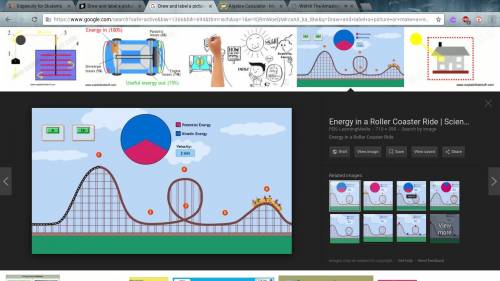
Physics, 04.08.2019 20:00 sgalvis455
Draw and label a picture or make a real life model of something to display conservation of energy. make sure it is something that demonstrates going from potential energy to kinetic energy and back again. for example you could draw a roller coaster, make a pendulum, draw a skateboard park or create something else. be creative! make sure your work is original! do not copy and paste from a website or other source. write a paragraph or story to explain the transformation between potential and kinetic energy as shown in your picture or model. you should have at least 5 complete sentences with a main idea and supporting details. make sure your work is original! do not copy and paste from a website or other source. you can turn in your finished project as a video, a power point, a word document, a hand drawn picture and paragraph, or some other form of presentation. make sure it clearly shows your project and explains the relationship between kinetic and potential energy.

Answers: 1


Another question on Physics

Physics, 21.06.2019 22:30
Which expression allows you to determine the mechanical advantage of an inclined plane? a. height of plane / input force b. length of plane / input force c. length of plane / height of plane d. height of plane / length of plane
Answers: 1

Physics, 22.06.2019 02:10
Astudent is performing an experiment comparing sound and light waves. the student gathers the following data. what conclusion does the student most likely make based on this data? light waves always travel the same speed; however, the speed of sound is determined by the medium that it travels through. all sound waves always have the same energy, so the temperature of the medium does not affect wave speed. light needs to vibrate particles, so it travels fastest in tightly packed solids, while sound does not need a medium, so it travels fastest in a gas. tightly packed particles in solids slow down the light waves; however, sound waves make particles bounce into each other, so they travel faster in solids.
Answers: 3

Physics, 22.06.2019 02:50
An alligator swims to the left with a constant velocity of 5 \,\dfrac{\text{m}}{\text s}5 s m ? 5, space, start fraction, m, divided by, s, end fraction. when the alligator sees a bird straight ahead, the alligator speeds up with a constant acceleration of 3 \,\dfrac{\text {m}}{\text s^2}3 s 2 m ? 3, space, start fraction, m, divided by, s, start superscript, 2, end superscript, end fraction leftward until it reaches a final velocity of 35 \,\dfrac{\text {m}}{\text s}35 s m ? 35, space, start fraction, m, divided by, s, end fraction leftward. how many seconds does it take the alligator to speed up from 5 \,\dfrac{\text {m}}{\text s}5 s m ? 5, space, start fraction, m, divided by, s, end fraction to 35 \,\dfrac{\text {m}}{\text s}35 s m ? 35, space, start fraction, m, divided by, s, end fraction?
Answers: 3

Physics, 22.06.2019 08:00
A0.580-kg rock is tied to the end of a string and is swung in a circle with a radius of 0.500 meters. the velocity of the rock is 4.50 m/s. what is the centripetal force acting on the rock? 15.5 n 5.22 n 69.8 n 23.5 n
Answers: 2
You know the right answer?
Draw and label a picture or make a real life model of something to display conservation of energy. m...
Questions

History, 30.11.2020 21:40

Biology, 30.11.2020 21:40


Mathematics, 30.11.2020 21:40


Mathematics, 30.11.2020 21:40






History, 30.11.2020 21:40

Mathematics, 30.11.2020 21:40

Chemistry, 30.11.2020 21:40



Spanish, 30.11.2020 21:40

Mathematics, 30.11.2020 21:40

Mathematics, 30.11.2020 21:40




